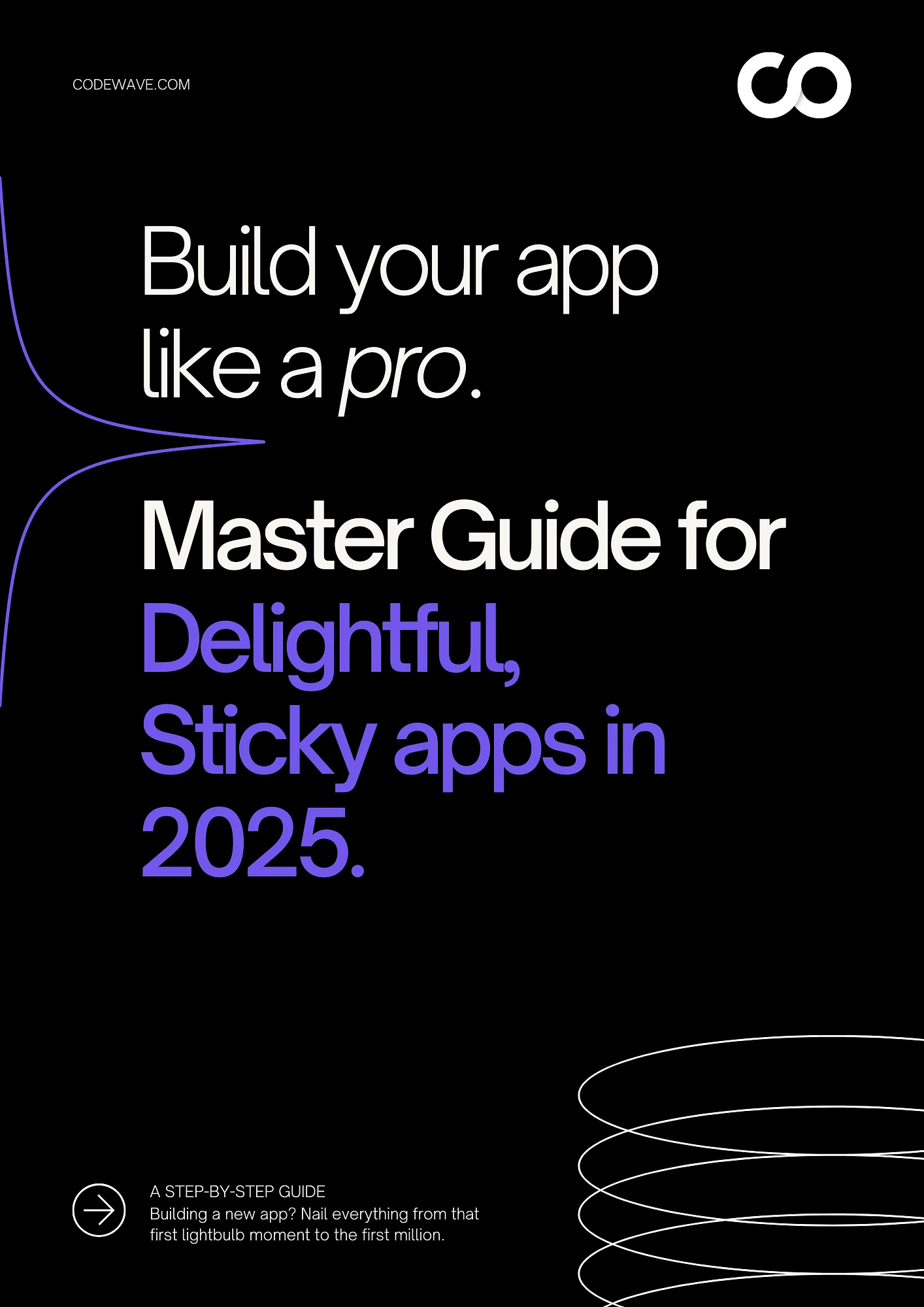You’re sitting in a café, your laptop open, a notepad scribbled with ideas, and a head full of dreams. You’ve got it—the idea. The one that could change the game, disrupt the industry, and maybe even land your name in the startup hall of fame.
But then comes the flood of questions.
- Where do you start?
- What features do you build first?
- How do you know if people will actually care?
It’s not about building something perfect. It’s about building something purposeful. 42% of startups fail because people simply don’t want what they’re selling. That’s wild—but it’s also avoidable. This is where the MVP (Minimum Viable Product) becomes your ultimate game-changer. It’s not about perfection; it’s about purpose.
Airbnb started with air mattresses in a living room. Instagram began as a simple photo app called Burbn. Their MVPs weren’t flashy, but they worked—they validated ideas, attracted users, and paved the way for massive growth.
So, why is an MVP so crucial for startup success? Let’s break it down before diving into the six steps to get yours right.
Why MVP is Important for Tech Startups
In the fast-moving world of tech startups, time and resources are everything. An MVP (Minimum Viable Product) is your chance to get ahead without overcommitting. It’s about starting small, learning fast, and building smarter.
1. Validate Your Idea
Imagine spending months building a product, only to hear crickets after launch. Painful, right? That’s the reality for many startups. An MVP prevents this by letting you test your idea early.
Take Dropbox, for example. Before they wrote a single line of code, they released a demo video showing how their product would work. That simple video generated thousands of signups, proving there was demand.
Lesson: Build only what you need to confirm your idea resonates.
2. Save Time and Money
“Don’t spend $100,000 on a product no one wants,” says Eric Ries, author of The Lean Startup. With an MVP, you avoid overbuilding by focusing on essentials.
For example, Zappos, now a billion-dollar company, started by testing the idea of selling shoes online. The founder didn’t create a full-fledged e-commerce platform. Instead, he took pictures of shoes in local stores and posted them online to see if people would buy them. It worked, and Zappos scaled from there.
Lesson: Less is more when you’re starting. Test first; build later.
3. Attract Early Adopters
Your MVP isn’t just about proving your idea works—it’s about finding your first users. These early adopters are often your most loyal customers and your best source of feedback.
Instagram, for instance, launched as a much simpler app focused solely on photo sharing. They listened to early users, scrapped features people didn’t care about, and focused on filters. That pivot turned them into a global phenomenon.
Lesson: Your first users aren’t just customers—they’re co-creators.
4. Impress Investors
Investors love proof, and nothing says “this idea works” like a functioning MVP. It shows you’re not just dreaming—you’re doing. A working product, even a basic one, gives them confidence in your ability to execute.
Look at Airbnb. Their MVP wasn’t glamorous. They rented out their own apartment with air mattresses to see if people would pay to stay. They did. That scrappy beginning was enough to land their first round of funding.
Lesson: A solid MVP turns “maybe” into “yes” for investors.
An MVP is more than just a starting point. It’s your startup’s lifeline, the tool that helps you focus, learn, and adapt in real time. Build smart, and your MVP will become the foundation of something extraordinary.
Also read: What is MVP in Software Development?- Complete Guide
Now that we’ve established why an MVP is crucial, it’s time to roll up your sleeves and build one. But where do you start? How do you go from idea to a product that users can touch, feel, and fall in love with?
MVP Development for Tech Startups- 6 Steps
Step 1: Define Your Problem Statement
Every successful product starts with a clearly defined problem. Your MVP isn’t about solving every problem—it’s about solving one problem really well. Start by identifying a specific pain point your target audience faces.
How to Define Your Problem Statement
- Understand the Root Cause: Use the “5 Whys” technique to dig deeper into surface-level issues. For instance, if the problem is “customers can’t find nearby taxis,” keep asking “why” until you reach the core issue—e.g., drivers and riders lack a reliable way to connect.
- Test the Problem: Speak to potential users. Conduct surveys or interviews to validate whether this problem truly exists and if it’s significant enough to solve.
Example:
When Uber launched, their problem statement was simple: “People can’t find reliable, quick transportation in urban areas.” Their MVP addressed this directly by connecting riders to drivers through a mobile app.
Action Tip: Write your problem statement in one clear sentence. Avoid jargon or complexity. This will guide every decision you make while building your MVP.
Step 2: Identify Your Target Audience
Your product isn’t for everyone—at least not initially. Narrowing your focus to a specific group of users allows you to design an MVP that speaks directly to their needs.
Steps to Identify Your Audience:
- Segment Your Market: Break your audience into groups based on demographics, behavior, and pain points.
- Build Personas: Create detailed profiles of your ideal users. Include their goals, frustrations, and motivations.
- Talk to Real Users: Validate your personas through direct interaction. Tools like Typeform for surveys or Zoom for interviews can help.
Example:
Spotify’s initial target audience was tech-savvy millennials who were frustrated by slow, illegal music downloads. Their MVP focused on delivering instant, high-quality streaming to this group, and they gradually expanded from there.
Tip: Focus on the 20% of your audience that will bring 80% of your value. Early adopters are often the most vocal and invested.
Step 3: Map Out Core Features
An MVP is about simplicity. Instead of building a fully-featured product, identify the one thing your product must do to deliver value.
Steps to Prioritize Features:
- Brainstorm Everything: List every feature you can think of, no matter how big or small.
- Prioritize Using MoSCoW:
- Must-Have: Features essential for solving the core problem.
- Should-Have: Features that enhance the experience but aren’t critical.
- Could-Have: Nice-to-haves that can wait.
- Won’t-Have: Features that are out of scope for the MVP.
- Focus on the ‘Must-Haves.’ If it doesn’t directly solve your problem statement, cut it.
Example:
Instagram’s MVP launched with three core features: photo uploading, filters, and sharing. They excluded direct messaging, video, and stories, focusing solely on creating a seamless photo-sharing experience.
Tip: Always ask, “Does this feature solve the core problem for my audience?” If the answer is no, save it for later iterations.
Step 4: Build, But Keep It Lean
Now it’s time to bring your MVP to life. Remember, your goal isn’t to create a polished, perfect product—it’s to create a functional version that showcases your core value.
Options for Building Your MVP:
- No-Code Tools: Platforms like Bubble, Webflow, or Glide let you build basic apps or websites without technical expertise.
- Low-Code Solutions: Use frameworks like React or Flutter for quicker development.
- Prototypes: Create interactive mockups using Figma, Adobe XD, or InVision to test ideas before coding.
- Outsourcing: Hire freelancers or agencies if your team lacks technical expertise.
Example:
Dropbox started with a demo video showing how their product would work. They didn’t build any software until they validated demand through signups.
Your idea has potential—let’s brainstorm how to make it real, together.
Tip: Set a strict deadline for MVP development—ideally 4-8 weeks. This forces you to focus and avoid overbuilding.
Step 5: Launch and Gather Feedback
Your MVP isn’t complete until it’s in users’ hands. This step is all about learning—watching how users interact with your product and understanding what they need.
How to Gather Feedback:
- Beta Testing: Launch to a small group of early adopters.
- Behavior Analytics: Use tools like Google Analytics, Hotjar, or Mixpanel to track user behavior and identify pain points.
- Surveys & Interviews: Directly ask users about their experience. Use open-ended questions to uncover insights you didn’t expect.
Example:
Slack’s team used their MVP internally, identifying bugs and refining the experience before launching publicly. This allowed them to deliver a polished product to early adopters.
Tip: Don’t just rely on what users say—observe what they do. Behavioral patterns often reveal insights that feedback alone can’t.
Step 6: Iterate and Improve
An MVP isn’t the final product—it’s the beginning of an ongoing journey. The feedback you collect will guide the next steps, helping you improve and adapt your product to meet user needs.
How to Iterate Effectively:
- Set Metrics: Define what success looks like. Common metrics include retention rate, engagement, and feature adoption.
- Plan Updates: Use agile methodologies to release updates in small, frequent cycles.
- Test and Refine: Continuously test changes with real users before scaling.
Example:
Twitter’s MVP started as a simple status-sharing tool called “Twttr.” Early users requested hashtags to organize tweets, and Twitter quickly adapted. This feature became one of its defining characteristics.
Tip: Be open to pivots. If your feedback suggests a completely new direction, don’t resist. Many great products were born from pivots, including Instagram and Slack.
The world doesn’t need another unfinished idea. Let’s create something extraordinary together and bring your MVP to life.
Now that you know how to build an MVP and measure its success, it’s crucial to learn from others’ mistakes. Many startups stumble at this stage—not because their ideas are bad, but because they fall into avoidable traps.
By understanding these common pitfalls, you can steer your MVP journey in the right direction.
Common MVP Mistakes in MVP Development for Startups
Even with the best intentions, startups can stumble during MVP development. Avoiding these common mistakes will save time, resources, and unnecessary frustration. Let’s look at where things often go wrong:
1. Overbuilding the MVP
The most frequent mistake is trying to do too much, too soon. An MVP should focus on solving one core problem—not cramming in every feature you’ve dreamed of.
- Why It Happens: Founders often fear their MVP will seem “too simple” or unappealing to users.
- The Impact: Overbuilding leads to longer development times, higher costs, and a diluted product that’s harder to test.
How to Avoid It: Ruthlessly prioritize features using frameworks like MoSCoW (Must-Have, Should-Have, Could-Have, Won’t-Have). Ask yourself, “If this feature didn’t exist, would the product still solve the core problem?”
2. Skipping User Validation
Too many startups launch their MVP without involving real users in the process. They rely on assumptions rather than data, which can lead to building something no one wants.
- Why It Happens: It’s easy to fall in love with your idea and assume others will, too.
- The Impact: You risk wasting time and money on a product that doesn’t resonate with your target audience.
How to Avoid It: Engage your audience early. Conduct surveys, interviews, or beta tests before launch. Tools like Typeform or Google Forms can help you gather meaningful feedback quickly.
3. Ignoring Feedback
Feedback is the backbone of the MVP process. Ignoring what users are saying—or cherry-picking the feedback that fits your vision—can doom your startup.
- Why It Happens: Sometimes, founders resist feedback that challenges their original idea.
- The Impact: You miss out on critical insights that could improve your product and better meet user needs.
How to Avoid It: Create a structured feedback system. Categorize user input into themes, and prioritize changes based on frequency and impact. Remember, criticism is an opportunity to improve—not a personal attack.
4. Choosing Vanity Metrics Over Actionable Ones
Metrics are essential for tracking progress, but focusing on the wrong ones can give a false sense of success.
- Why It Happens: Vanity metrics like total downloads or social media followers are tempting because they look impressive.
- The Impact: You might overlook critical issues like low engagement or poor retention.
How to Avoid It: Focus on actionable metrics like retention, engagement, or conversion rates. These provide meaningful insights into whether your MVP is solving the problem effectively.
5. Launching Too Late
The fear of launching an imperfect product often delays MVP releases. Founders keep refining and tweaking, waiting for “the perfect moment.”
- Why It Happens: Perfectionism and fear of failure.
- The Impact: You lose valuable time for testing, feedback, and iteration—and risk being outrun by competitors.
How to Avoid It: Embrace the concept of a “good enough” MVP. As Reid Hoffman, founder of LinkedIn, famously said, “If you are not embarrassed by the first version of your product, you’ve launched too late.”
6. Misunderstanding the Role of the MVP
Some startups treat the MVP as the final product, expecting it to perform perfectly in the market. They forget that an MVP is a tool for learning—not a polished, finished product.
- Why It Happens: Lack of clarity about the purpose of an MVP.
- The Impact: Unrealistic expectations lead to disappointment when early results don’t match the vision.
How to Avoid It: Approach your MVP as an experiment. Focus on learning and improving rather than immediate success.
Your Idea Deserves More Than a Sketchpad
Every great startup starts with a bold idea. But ideas alone don’t change the world—execution does. MVP development for startups is the bridge between concept and reality, the first step in making your vision tangible.
Don’t let your idea stay on the drawing board. Build smart, learn fast, and create something that truly matters with Codewave. Whether you’re taking your first step or refining your roadmap, the right MVP can set the foundation for success. Bold ideas deserve bold action. Contact us—and let’s make it happen.
Codewave is a UX first design thinking & digital transformation services company, designing & engineering innovative mobile apps, cloud, & edge solutions.







